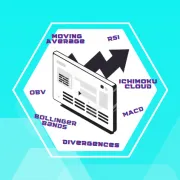Risk management is an important part of any trading or investment strategy, and this is especially true in the world of cryptocurrency. The high volatility and lack of regulation in the crypto market can lead to significant losses if proper risk management techniques are not employed.
Risk management refers to the processes traders and investors put in place to help keep losses under control and achieve a good risk/reward ratio while trading or investing. It involves developing strategies to reduce losses and maximize gains.
In this blog post, we will discuss key risk management strategies that crypto traders and investors can use to protect their portfolios and maximize their chances of success. We will be looking at what risk management is, why risk management is important, how to manage risk while trading and investing, and risk management strategies, tools, and resources.
Article summary
What is Risk Management?
The process of identifying, assessing, and managing the risks associated with any investment or trading activity is called Risk Management. It involves understanding the likelihood of an investment or trade losing money as well as the potential for it to generate profits. It also includes strategies to manage the risk and prevent losses, as well as techniques to maximize potential gains.
Risk management’s goal is to ensure that the risks associated with any trading or investment activity are minimized, while at the same time maximizing the potential for profits. Risk management is an essential component of any trading or investment strategy and should be taken into consideration when making trading or investment decisions.
Why is Risk Management Important?
Crypto markets are highly volatile, with prices fluctuating significantly in short periods of time. This volatility presents significant risks to traders and investors, including the potential for significant losses. To minimize the impact of these risks, it is important to implement a risk management strategy.
Effective risk management can help to preserve capital and ensure that traders and investors are able to make informed decisions about their investments. It can also help to reduce the overall level of stress and anxiety associated with trading and investing in crypto markets.
How to Manage Risk in Trading and Investing
There are several steps that traders and investors can take to manage risk in crypto markets:
- Diversify your portfolio: One of the most effective risk management strategies is to diversify your portfolio. This means spreading your investments across a range of different cryptocurrencies, rather than putting all your eggs in one basket. By diversifying, you can reduce the impact of any one particular coin on your overall portfolio. For example, if you have a portfolio that is heavily weighted towards Bitcoin and it suffers a major price drop, your entire portfolio will be affected. However, if you have a diverse portfolio with a range of coins, the impact of any one coin’s price drop will be less significant.
- Use stop-loss orders: Stop-loss orders are a useful tool for limiting potential losses on a trade. They allow you to set a certain price at which your trade will automatically close, thereby limiting your potential losses. For example, if you buy a coin at $100 and set a stop-loss order at $90, your trade will automatically close if the price of the coin drops to $90. This can help you minimize potential losses if the market moves against you.
- Use limit orders: Limit orders allow you to set a specific price at which you would like to buy or sell a coin. This can be useful for maximizing your profits on a trade. For example, if you buy a coin at $100 and set a limit order to sell at $120, your trade will automatically close once the price of the coin reaches $120. This can help you lock in your profits and avoid the temptation to hold onto a coin in the hope that it will go even higher.
- Use risk-reward ratios: Risk-reward ratios are a way of measuring the potential risk and reward of a trade. The basic idea is to compare the amount of money you are risking on a trade to the potential reward if the trade is successful. For example, if you are risking $100 on a trade with a potential reward of $200, your risk-reward ratio is 1:2. In general, it is advisable to aim for trades with a risk-reward ratio of at least 1:2, which means that the potential reward is at least twice the amount of money you are risking.
- Regularly review your portfolio: It is important to regularly review your portfolio to ensure that it is still in line with your risk tolerance and investment objectives. This can help to ensure that you are not taking on more risk than you are comfortable with.
Risk Management Techniques for Different Types of Trading and Investing
Traders and investors can use a variety of risk management techniques to manage their risk. Different types of trading and investing may require different risk management techniques. Here are a few examples:
- Long-term investing: If you are a long-term investor, you may be more concerned with minimizing the overall risk of your portfolio. In this case, diversification and regular portfolio review may be particularly important.
- Day trading: If you are a day trader, you may be more concerned with minimizing the risk of individual trades. In this case, setting limits on your trades and using stop-loss orders may be particularly important.
- Margin trading: If you are using margin to trade, you may be taking on significantly more risk than you would with regular trading. In this case, it is especially important to carefully manage your risk, including setting limits on your trades and using stop-loss orders.
Conclusion
Risk management is a critical part of success in the world of cryptocurrency trading and investing. By implementing strategies such as diversification, stop-loss orders, limit orders, and risk-reward ratios, you can help protect your portfolio and increase your chances of success in the highly volatile crypto market.
Regardless of your trading or investing style, it is important to implement a risk management strategy to protect yourself from significant losses. By identifying and managing risk, you can help to ensure the long-term success of your crypto portfolio.

Founder & CEO of Vestinda.
Compacting years of investment portfolio building into just a few minutes.







